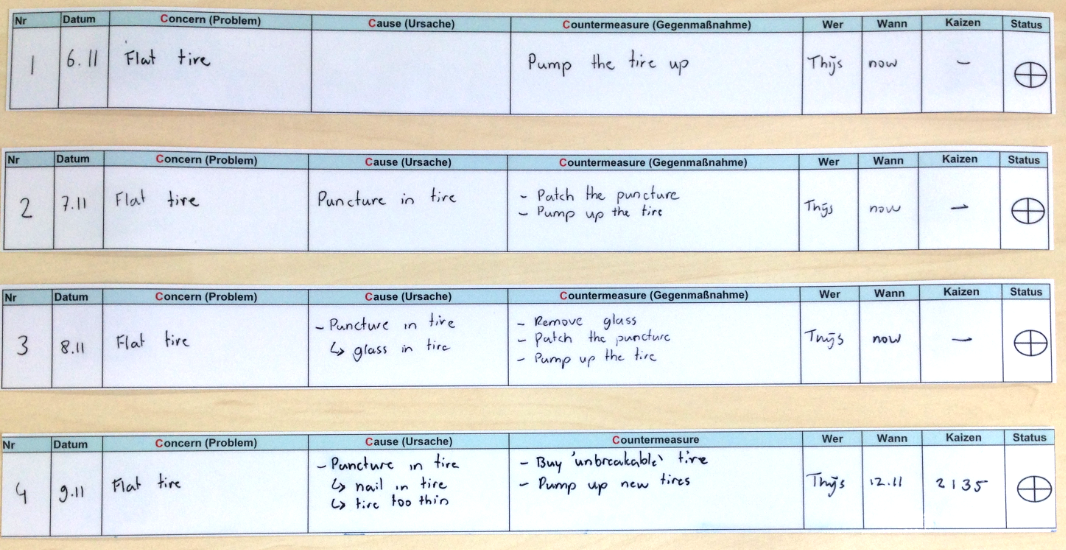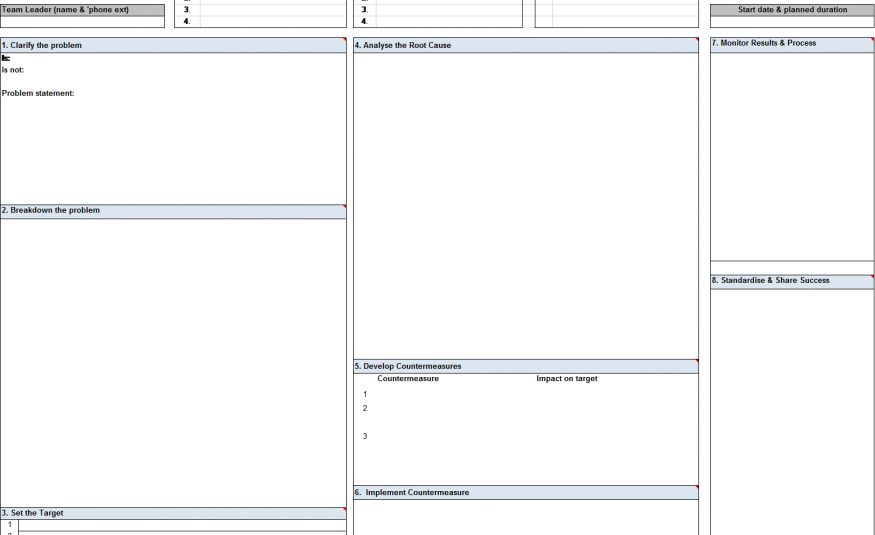Next to improving the flow of goods and services in a value stream, Lean also focusses on improving the flow of problems (Ballé & Ballé, 2012). Problems are documented and solved on the team board and escalated to a higher level Team board when the team is not able to solve the problem themselves (Mann, 2005). But how do you really solve a problem? This article describes the practice of root cause analysis and the link between the root cause analysis, team boards and the kaizen loop.
The first step in understanding the problem solving methodology, it is important to understand the 3C METHOD, which is used to document and problems and actions on the Team boards (see illustration 1)

Illustration 1: Example of a 3C template
The 3C ´s stand for Concern, Cause and Countermeasure and encourage employees to think about the definitions of each of these steps.
The owner and the date the countermeasure should be implemented are also documented.
The Kaizen column is used to evaluate your countermeasure. Is it a fire fighting ´back to standard´ solution or a real preventative ´raise the standard´ solution? If it is a raise the standard solution, the kind of improvements we are looking for within the Lean philosophy, the improvement of the standard should be documented on the kaizen and the kaizen number can be put on the 3C.
Finally, the 3C includes a PDCA circle, to be able to track the status of the problem in all stages of problem solving.
Lean puts focus on continuously improving standards, on kaizen, and it is therefore the goal to have as many 3C´s linked to Kaizen as possible. The ratio 3C´s with Kaizen to the 3Cs which are not linked to kaizen are one measure of Lean maturity.
To improve this ratio, and improve the number of 3C´s link to kaizen, a root cause analysis is necessary. This is where the 5x Why comes in.
In the following example, which I personally use in trainings and is described in my book Lean Transformations, the use of the 5X WHY to help you find the real root cause of the problem is explained. As a Dutch guy, I like taking my bike to work. As a standard, I defined that my (random) tires should always be filled with air, up to a certain barometric pressure.
- On Monday morning, I plan to take the bike to work, when I realize I have a flat tire. I do a very quick 3C, without analysis, pump up the tire and cycle to work to make sure I do not miss my early morning meeting. This clearly is a quick fix solution, a back to the standard countermeasure.
- On Tuesday morning I want to cycle to work again, but realize the same tire is flat again. Apparently I have not analyzed the problem properly yesterday so today I ask myself why the tire is empty. I find there is a puncture in the tire which needs to be patched. After I patched the tire, I quickly cycle to work. Even though I did more than yesterday, this countermeasure is still a back to standard action.
- On Wednesday morning, my tire is flat for the third time this week. I´m starting to get annoyed but do take the time for a slightly better analysis than yesterday.
Why is my tire flat? Because there is a puncture in the tire
Why is there a puncture in the tire? Because a piece of glass got stuck into the outside tire.
Solution: I remove the glass from the outer tire, patch the puncture, pump up the tire and cycle to work.
I would ask the group now, whether I have raised the standard or that the countermeasure was a classical back to standard action. Just like Monday and Tuesday, even though I asked why a couple of times, removing the glass and patching the tire is still a back to standard countermeasure, as I was to find out on Thursday. - On Thursday morning, I find myself with a flat tire again. This time however, I am motivated to do a real root cause analysis.
Why is my tire flat? Because there is a puncture in it
Why is there a puncture in my inner tire? Because a nail punctured through it.
Why is there something puncturing my tire for the second time this week? The outer tire might not be protective enough to cycle through the rough streets of Hamburg.
Solution: invest in new ´unbreakable´ tires over the weekend.
This last solution is the first solution this week that actually describes an improvement of the standard. Monday to Wednesday, I only executed some short term quick fixes to get my bike functioning again. Only on Thursday I found a possible root-cause for my problem, the reason I got ´so many´ flat tires. This led to a proper solution, in this case buying a better tire, to prevent something from puncturing it again.
The 3C´s described in this example, are visualizes in Illustration 2.

Illustration 2: Documented 3Cs, number 4 being the most desirable while it is linked to kaizen. (SOURE: Panneman, 2017)
Having problems in keeping the standard is just one of the possible types of problems which can be addressed on the Team boards. There are three in total:
- The standard is not good enough (like the flat tire example)
- The standard is not achieved anymore, for instance a KPI that is ´red´
- A team member has identified one of the 8 wastes and would like to address it.
When all teams in an organization solve problems like these on a continuous basis using the root cause analysis, the performance of the organization will improve drastically. When the 3C´s are only used for firefighting, which means the standards are not being raised. There will be no measureable improvement of performance in the long term. A thorough root cause analysis is therefore one of the most important pin points in any (Lean) organization.
Continue to:
Lean Toolbox - Takt-, Cycle-, process- and Lead Time
REFERENCES:
Ballé, F., & Ballé, M. (2012). De Lean Manager - een roman over een Lean Transformatie. Driebergen (NL): Lean Management Instituut. (summary / order this book)
Mann, D.,2005, Creating a Lean Culture - Tools to sustain Lean Conversions, New York: Productivity Press. (summary / order this book)
Panneman, T, 2017, Lean Transformations - when and how to climb the four steps of Lean maturity, Maarssen (NL): panview (summary / Order this book)












